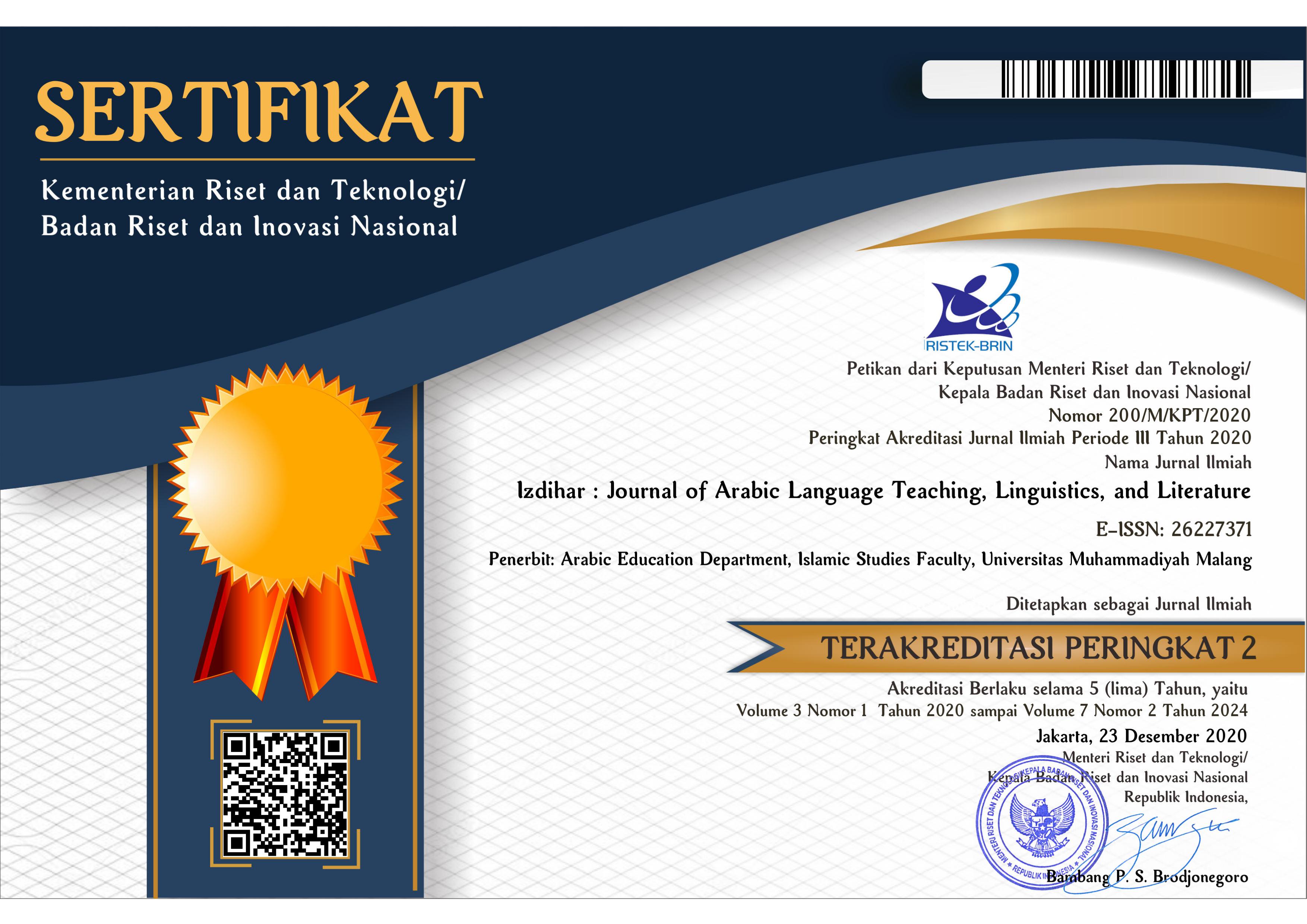Analysis of Textbook “Ilmu Saraf Untuk Pemula” Third Edition Writen by Abu Razin and Ummu Razin (Development Textbook Principles)
DOI:
https://doi.org/10.22219/jiz.v6i1.22562Keywords:
analysis of book, Arabic MorphologyAbstract
This article aimed to analyze the book "Sarf science for beginners third edition by Abu Razin and Ummu Razin" based on the theory of development textbook principles and to find out the strengths and weaknesses of textbook. This research was qualitative method, it is literature research with descriptive analysis method. According to the results of this research, the Sharaf Science book for beginners has been revised and developed twice, based on suggestions and recommendations from teachers and students. The sociocultural principle is a weakness in this textbook because the author paid little attention to this principle, especially in giving examples in the discussion of sarf which aims to understand the Qur'an. Supposedly, giving examples in this book should also represent the themes of Arab culture. There is no appropriate use for this book for learners who is younger than 15 years old since it doesn't address the psychological state of these learners. The principles of psychology, pedagogy, and language are the strengths of this book. There are several striking strengths of this book, including how the author facilitates the ability of students to learn independently, and how teachers are given several videos for free about the explanation and teaching of the book, directly practiced by the author. This textbook still has few typos and a lot of blank spaces on some pages, and it does not explain in detail, for example in the discussion of fi'il mu'tal, the origin of the word and the history of its changes, although the author has provided a video of the learning process on YouTube. How good it would be if the explanation was later included in the book.
Downloads
References
Aliyah. (2018). Pesantren Tradisional Sebagai Basis Pembelajaran Nahwu Dan Sharaf Dengan Menggunakan Kitab Kuning. Al-Ta’rib, Jurnal Pendidikan Bahasa Arab Dan Kebahasaaraban, Vol. 6 No. 1. https://doi.org/10.23971/altarib.v6i1.966
Arifatun, N. (2012). Kesalahan Penerjemahan Teks Bahasa Indonesia Ke Bahasa Arab Melalui Google Translate (Studi Analisis Sintaksis). Journal of Arabic Learning and Teaching, LAA 1 (1). https://journal.unnes.ac.id/sju/index.php/laa/article/view/1506
Asep, S. (2008). Analisis Buku-Buku Ilmu Sharaf Dan Manfaatmya Bagi Pengajaran Ilmu Sharaf Di Upi. S1 Thesis, Universitas Pendidikan Indonesia.
Asyrofi, S., & Pransiska, T. (2016). Penulisan buku teks Bahasa Arab: Konsep, prinsip, problematika, dan proyeksi. Penerbit Ombak.
Cahya Edi Setyawan dkk. (n.d.-a). Telaah Bahan Ajar Bahasa Arab “Ayo Fasih Berbahasa Arab” Madrasah Aliyah Kelas Xii Karya Hasan Saefullah (Tinjauan Materi Berdasarkan Teori Mackey): Vol. No 4 (2018). Konasbara. http://prosiding.arab-um.com/index.php/konasbara/article/view/273
Elwin Walimatul Fara. (n.d.-b). Pengembangan Media Aplikasi “Hayya Nata’allam As-Sharfa” Untuk Pembelajaran Sharaf. Prosiding Semnasbama IV UM Jilid 2. http://prosiding.arab-um.com/index.php/semnasbama/article/view/578
Ihwan, M. B., Mawardi, S., & Ni’mah, U. (2022). Pengaruh Penguasaan Ilmu Nahwu Dan Sharaf Terhadap Kemampuan Membaca Kitab Fathul Qarib. TADRIS AL-ARABIYAT: Jurnal Kajian Ilmu Pendidikan Bahasa Arab, 2(1), 61–77. https://doi.org/10.30739/arabiyat.v2i1.1422
Ilmi, N. F. (2021). Metode “Tamyiz” Untuk Pembelajaran Nahwu Dan Sharaf Pada Al-Qur’an. International Conference of Students on Arabic Language, 5(0), Article 0. https://prosiding.arab-um.com/index.php/semnasbama/article/view/806
Jamani, K. R., & Shameli, A.-A. (2023). De-militarization of Language in Arabic grammar books and its Impact on Human life. International Multi. J. of PURE LIFE, Winter(1). https://doi.org/10.22034/imjpl.2023.14280.2275
Kesuma, M. & Reni Puspita Sari. (2020). Pengembangan Modul Sharaf Dengan Pendekatan Deduktif Di Pondok Modern Madinah Lampung. Studi Arab, 11(1), 27–36. https://doi.org/10.35891/sa.v11i1.1944
Pamessangi, A. A. (2019). Analisis Kesulitan Belajar Bahasa Arab Mahasiswa Program Studi Pendidikan Bahasa Arab Iain Palopo. AL IBRAH: Journal of Arabic Languange Education, 2(1), Article 1. https://doi.org/10.24256/jale.v2i1.1206
Program – BISA Learning Centre. (n.d.). Retrieved 25 March 2021, from http://blc.bisa.id/kelas-blc/
Razin, A., & Razin, U. (2017). Ilmu Sharaf untuk Pemula (Cetakan III). Maktabah BISA.
Roviin, R. (2018). Analisis Buku Teks Al ‘Arabiyah Li Al Nasyi’in Karya Mahmud Ismail Shini, dkk. Jurnal Al Bayan: Jurnal Jurusan Pendidikan Bahasa Arab, 10(01). https://doi.org/10.24042/albayan.v10i01.2594
Supriadi, R., & Fitriyani, N. (2021). Analisis Kesesuaian Buku Teks Bahasa Arab Berbasis Keterbacaan Menggunakan Ketentuan Fog Index. Arabi : Journal of Arabic Studies, 6(1), Article 1. https://doi.org/10.24865/ajas.v6i1.232
Sya’roni, M. (2019, February 21). Interview with chairman of "BLC (Arabic Language Center) Yogyakarta [Voice recording].
Talqis Nurdianto & Noor Azizi bin Ismail. (2020). Pembelajaran Bahasa Arab Berbasis Common European Framework Of Reference For Language (CEFR) Di Indonesia. al Mahāra: Jurnal Pendidikan Bahasa Arab, 6(1), 1–22. https://doi.org/10.14421/almahara.2020.061.01
Visi Misi | Belajar Islam dan Bahasa Arab (BISA). (n.d.). Retrieved 25 March 2021, from http://www.bisa.id/visi-misi/
yayasanbisa. (2017, May 14). Ebook ilmu Sharaf Untuk Pemula Cetakan Ketiga Telah Terbit! Belajar Islam Dan Bahasa Arab (BISA). https://www.bisa.id/ebook-ilmu-sharaf-untuk-pemula-cetakan-ketiga-telah-terbit/
Downloads
Published
How to Cite
Issue
Section
License
Copyright (c) 2023 Afdhal Fikri Mirma;Talqis Nurdianto; Settings Zainal Abidin Hajib;Izdihar : Journal of Arabic Language Teaching, Linguistics, and Literature

This work is licensed under a Creative Commons Attribution-ShareAlike 4.0 International License.
Copyright Notice
Authors who publish with this journal agree to the following terms:
- Authors retain copyright and grant the journal right of first publication with the work simultaneously licensed under a Creative Commons Attribution-ShareAlike 4.0 International License that allows others to share the work with an acknowledgment of the work's authorship and initial publication in this journal.
- Authors are able to enter into separate, additional contractual arrangements for the non-exclusive distribution of the journal's published version of the work (e.g., post it to an institutional repository or publish it in a book), with an acknowledgment of its initial publication in this journal.
- Authors are permitted and encouraged to post their work online (e.g., in institutional repositories or on their website) prior to and during the submission process, as it can lead to productive exchanges, as well as earlier and greater citation of published work (See The Effect of Open Access).
Copyright (c) 2019 Izdihar : Journal of Arabic Language Teaching, Linguistics, and Literature

This work is licensed under a Creative Commons Attribution-ShareAlike 4.0 International License.


















